Key points:
- Japanese yen stabilised around 146.5 per dollar after hitting a near two-week high.
- Strong U.S. economic concerns and potential Fed rate cuts bolster the strength of the Japanese yen.
- Japanese economic indicators, including machinery orders and GDP growth, exceed expectations.
The Japanese yen maintained its position near a two-week high against the U.S. dollar on Tuesday, trading around the 146.5 level. This stability comes after the yen gained ground in the previous session, driven by rising expectations that the U.S. Federal Reserve may soon begin cutting interest rates.

Picture: USD losing strength against JPY on Fed rate cut expectations, as observed on the VT Markets app.
The charts reveal a bigger picture. The USD/JPY pair has been on a downward trajectory, currently trading around 146.308, reflecting the recent dovish shift in market sentiment towards U.S. monetary policy.
Recent comments from Federal Reserve officials have raised concerns about the U.S. labour market and broader economic conditions, leading to speculation that the central bank could lower borrowing costs as early as next month. This anticipation of rate cuts has weakened the dollar, reducing its appeal against other currencies, including the yen.
The pair has been consistently trading below key Exponential Moving Averages (EMAs), particularly the 72-period EMA, which suggests a continuation of the bearish trend.
The MACD indicator also supports this outlook, with the MACD line hovering near the signal line, indicating a lack of strong momentum but still tilting towards bearish sentiment.
The recent low of 141.69 remains a critical level to watch, as a break below could signal further yen strength.
Related article: Hawkish vs dovish interest rate policy
Japanese economy regains some strength
In Japan, economic data continues to paint a positive picture. Machinery orders, often viewed as a leading indicator of capital expenditure, rose by 2.1% month-on-month in June, significantly outperforming the expected 1.1% increase. This suggests that businesses are more confident in making long-term investments, a sign of underlying economic strength.
Additionally, the Japanese economy expanded by 0.8% quarter-on-quarter in Q2, reversing a 0.6% contraction in the first quarter. On an annualised basis, the economy grew by 3.1%, surpassing forecasts of 2.1%. These robust figures have alleviated some concerns about Japan’s economic recovery and provided further support for the yen.
What to expect from the Japanese yen
Looking ahead, markets are eagerly awaiting domestic inflation data due later this week. The outcome of these figures will be crucial in determining the Bank of Japan’s next steps in its monetary policy. While the yen has been bolstered by expectations of the U.S. rate cuts, the Bank of Japan’s stance will play a critical role in shaping the currency’s trajectory.
Short term opportunities and risks
The potential for further gains hinges on the forthcoming U.S. and Japanese economic data, particularly inflation figures. The stabilisation of the Japanese yen around the 146.5 level suggests that the currency may encounter resistance as it approaches key resistance levels.
However, if the Fed signals a more aggressive rate-cutting cycle or if the inflation data of Japan surprises to the upside, the yen could break higher, offering trading opportunities.
Conversely, any indication that the Fed might delay rate cuts or that inflation remains subdued in Japan could lead to a pullback in the yen, making it crucial for traders to closely monitor market developments and adjust their positions accordingly.









